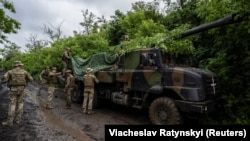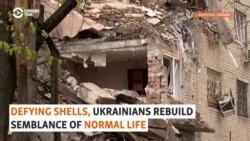The offensive began at dawn on October 10: At least three Russian battalions -- between 2,000 and 3,000 men -- moved with tanks and armored infantry vehicles, backed by an artillery fusillade pummeling Ukrainian positions.
Northwest of the city of Avdiyivka, home to a massive coke factory in the heart of the Donbas, the Russian units pushed southwest into the village of Berdychi and locked horns with units from Ukraine's 53rd Motorized Brigade. Other Russian units pressured Ukrainian lines to the south, trying to advance with small columns of armored vehicles.
The Russian goal, Ukrainian military officials and Western observers said, appears to be this: Encircle Ukrainian positions, create a "cauldron" to trap the units, and break Ukraine's hold on Avdiyivka, where Kyiv's forces have been able to pressure Russian lines to the east.
It's shaping up to be the biggest single offensive by Russia in months, possibly since the launch of its full-scale invasion of Ukraine in February 2022.
And it comes at a precarious time for Ukraine's forces, which are four months into their own big counteroffensive, pressing Russian lines at three locations in southern and eastern Ukraine. That counteroffensive is grinding forward slowly.
Ukrainian forces are holding their positions "in difficult fighting" near Avdiyivka, said Andriy Yermak, President Volodymyr Zelenskiy's chief of staff, in an October 13 post to Telegram.
"It's practically comparable to the first day [of the invasion], February 24, when they marched en masse, but this only on a separate small section of the front," Serhiy Tsekhotskiy, an officer of the 59th Separate Motorized Infantry Brigade, told RFE/RL's Ukrainian Service.
As many as three Russian battalions were involved in the offensive near Avdiyivka, the Ukrainian military's general staff said on October 10.
"The battles, both gunbattles and artillery duels, are fierce and really nonstop," said Vitaliy Barabash, head of the Avdiyivka city military administration. "Day and night, the occupiers are crawling like cockroaches, a lot."
Videos recorded by Ukrainian-operated drones showed columns of Russian vehicles moving along roads north the city on October 10. Open-source researchers said Russia may have lost up to three dozen vehicles in the initial assault.
The claim could not be independently confirmed.
"The strategic purpose of this settlement is absolutely obvious: Avdiyivka is the gateway to Donetsk," Taras Berezovets, a spokesman for Ukraine's 1st Separate Special Purpose Brigade, told Current Time.
The outskirts of Donetsk, the Russian-held administrative capital of the region of the same name, are about 10 kilometers south of Avdiyivka.
For its part, Russia has said little officially about the offensive. The Defense Ministry's regular updates include tallies of weapons fired and claims of Ukrainian losses but no mention of a major offensive.
But a host of Russian military bloggers and war reporters, many of whom have links to security agencies or military units, have documented the Russian effort.
In a post on October 11, Rybar, a closely watched Telegram channel affiliated with a former Russian Defense Ministry press officer, claimed Russian troops seized a slag heap near the Avdiyivka Coke and Chemical Factory. The factory is a sprawling industrial complex that was Ukraine's largest coke factory before the invasion. Later reports said Russian troops had lost the position to Ukrainian counterattack.
The facility, which supplied coke to metal smelters and heating plants around the country, is dormant now.
Denis Pushilin, the longtime head of the so-called Donetsk People's Republic, told the Russian state news agency RIA Novosti that Russian units were gaining ground north and south of Avdiyivka, "but it's too early to talk about a full-scale withdrawal." The Donetsk People's Republic is the name used by Moscow and anti-Kyiv forces to describe the Russian-controlled part of the Donetsk region.
"Generally speaking, it is not going as fast as we would like, but it is going," Boris Rozhin, a Russian blogger who writes under the name ColonelCassad, said in a post to Telegram.
Avdiyivka, which was briefly held by Moscow-backed separatists after the initial war against Kyiv broke out in 2014, was home to an estimated 32,000 people prior to the 2022 invasion.
Russian Reserves
Regardless of whether it succeeds, experts said, the Russian effort comes at a precarious moment, posing a challenge for Ukrainian forces.
After thwarting Russia's initial invasion effort to seize Kyiv, Ukraine scored surprising victories in late 2022, pushing Russian troops out of the northeastern Kharkiv region and recapturing parts of the southern Kherson region on the west bank of the Dnieper River.
WATCH: Living among ruins on the front lines of Russia's war on Ukraine, residents of Avdiyivka do more than hang on -- a few rebuild a semblance of normal life.
Ukraine's biggest counteroffensive effort was launched in early June. Despite a major influx of Western armor and weaponry, however, the effort has moved forward at a snail's pace as troops run into formidable Russian defenses known as the Surovikin Line -- named for the Russian general who oversaw their construction last year.
The southern Zaporizhzhya region, south of the town of Orikhiv, has been the main focus of the three-pronged effort. Ukrainian units have switched tactics away from highly coordinated "combined arms tactics" and are now focusing on small-scale, dismounted platoon advances on foot, in sequence with artillery barrages.
With the onset of fall and with winter on the way, the weather is already changing, and rains and mud will hinder movement for both Ukrainian and Russian vehicles and make trench warfare miserable for both sides.
In televised comments on October 13, Mykhaylo Podolyak, a senior adviser to Zelenskiy, complained the counteroffensive was "off schedule" due to delays from Western allies supplying weaponry.
"It's just that our partners were still afraid to admit that they needed to provide everything that Ukraine needed as quickly as possible," he said. "We are six to nine months behind schedule."
Also ominous for Ukraine is the fact that Russia was able to mount even a small-scale offensive given the estimated size of its losses.
U.S. officials have estimated Russian dead to be at least 120,000, with another 170,000 to 180,000 troops wounded, according to The New York Times. The same officials put Ukrainian losses at 70,000 killed and as many as 120,000 wounded.
Ukrainian and Western experts watching Russian troop levels have speculated that Russia would be unable to meet personnel demands and rotate units without another large-scale mobilization. Without that, experts predicted it would be hard to mount a concentrated assault against Ukrainian positions.
Still, there are hints of exhaustion among Russian units. Relatives of frontline soldiers have complained about units not being rotated out and replaced with rested soldiers.
Aleksandr Khodakovsky, a commander of Russian-backed forces in the Donetsk region who is known for frank accounts of battlefield conditions, called for Russian commanders to "freeze" the front lines for now.
"I believe that taking a break, temporarily replacing those mobilized on the front line with contract soldiers in order to allow the thinned and tired units to return to normal, and then begin a deliberate final phase -- that's acceptable," he said in a post to Telegram.














